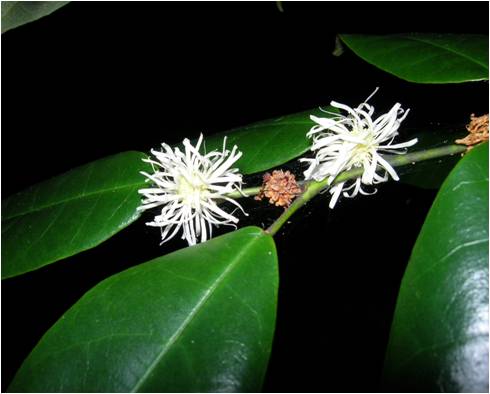Important Research Progress on Conservation of the Endemic Endangered Plant Species Loropetalum subcordatum
Loropetalum subcordatum, a shrub or small tree, belonging to the Hamamelidaceae family, has a narrow distribution range in the area within the Pearl River watershed. It is one of the most endangered angiosperm species in China with only four remnant populations and a few dozen individuals growing in the evergreen broadleaved forests of Guizhou and Guangdong provinces as well as the Hong Kong Special Administrative Region. It has been categorized as a National Protected Species (Class II) and listed in International Union for Conservation of Nature due to its rarity and vulnerability(http://www.iucnredlist.org/apps/redlist/search).
Tow researchers, led by Prof. ZHANG Dianxiang, from the Center of Systematic and Evolutionary Botany in South China Botanical Garden, CAS, have conducted research of pollination biology and conservation genetics on this highly endemic endangered plant species. The first researcher, Dr. GU Lei, studied the pollination biology and revealed facultatively autogamy without apomixes in this species. The possibility of outcrossing and the protogyny might indicate that the species was originally a crosser. Flowers pollinated in September-October usually start ovule growth in next summer, and set mature fruits in next October (after the next flowering peak), suggesting the occurrence of retard embryo development. The possibility that autogamy in Hamamelidaceae could have been developed from fly pollination. Another reseracher, Dr. GONG Wei, studied the conservation genetics of L. subcordatum. Totally 47 individuals from all the four extant populations were analyzed. Comparably low genetic diversity within populations was revealed and significantly high genetic differentiation among the populations was detected. Autogamy together with small population size, restricted distribution range, geographical isolation and limited seed dispersal contributes to its genetic diversity level and population genetic structure. Clonal reproduction was inferred to occur in the two populations of Hong Kong. Suggestions for conservation strategies were provided to preserve the four surviving populations in situ. Nature reserves need to be established locally. Inter-population introduction of individuals might be an effective strategy to retain genetic diversity within populations. Additionally, appropriate sites with similar habitats need to be selected near the wild populations for the purpose of ex situ conservation. Vegetative propagation of the individuals with different genotypes was suggested during ex situ conservation. Hopefully, all the genetic resources of this species could be preserved with increased population size and genetic diversity.
This research was published in two internal journals of Journal of Systematics and Evolution(42(3): 336-341)and Conservation Genetics (http://www.springerlink.com/content/xt4ux6500w785803/fulltext.pdf)

Loropetalum subcordatum
File Download: